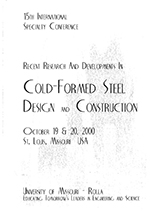Session Dates
19 Oct 2000
Abstract
Designing an automated procedure for the optimal design of any structural system poses special challenges. Converting this methodology into a practical tool is even more challenging. In this research, a point-and-click software system is developed for the optimal design of roof truss systems. The starting point is a roof template containing minimal user input - outline of the truss, truss spacing, load information, and cost figures. A ground structure is constructed as the starting point of the design iterations. The Genetic Algorithm (GA) is used as the optimization tool to drive the design changes. Using the database of available sections, the member cross-sections are selected for the top and bottom chords, and the webs. In addition, the number and layout of the web members is also determined. The final design is obtained so that the truss has the lowest cost and also satisfies AISI-LRFD design specifications. Numerical experience using the developed methodology and the software system on an Intel-based PC running Microsoft Windows OS shows that optimal designs can be obtained in a few minutes.
Department(s)
Civil, Architectural and Environmental Engineering
Research Center/Lab(s)
Wei-Wen Yu Center for Cold-Formed Steel Structures
Meeting Name
15th International Specialty Conference on Cold-Formed Steel Structures
Publisher
University of Missouri--Rolla
Document Version
Final Version
Rights
© 2000 University of Missouri--Rolla, All rights reserved.
Document Type
Article - Conference proceedings
File Type
text
Language
English
Recommended Citation
Mobasher, B.; Rajan, S. D.; and Chen, S. Y., "Automated Design of Steel Trusses" (2000). CCFSS Proceedings of International Specialty Conference on Cold-Formed Steel Structures (1971 - 2018). 1.
https://scholarsmine.mst.edu/isccss/15iccfss/15iccfss-session7/1
Automated Design of Steel Trusses
Designing an automated procedure for the optimal design of any structural system poses special challenges. Converting this methodology into a practical tool is even more challenging. In this research, a point-and-click software system is developed for the optimal design of roof truss systems. The starting point is a roof template containing minimal user input - outline of the truss, truss spacing, load information, and cost figures. A ground structure is constructed as the starting point of the design iterations. The Genetic Algorithm (GA) is used as the optimization tool to drive the design changes. Using the database of available sections, the member cross-sections are selected for the top and bottom chords, and the webs. In addition, the number and layout of the web members is also determined. The final design is obtained so that the truss has the lowest cost and also satisfies AISI-LRFD design specifications. Numerical experience using the developed methodology and the software system on an Intel-based PC running Microsoft Windows OS shows that optimal designs can be obtained in a few minutes.



